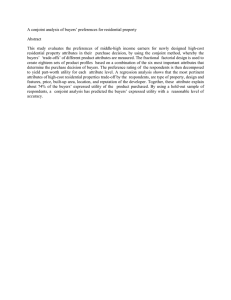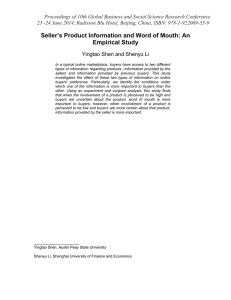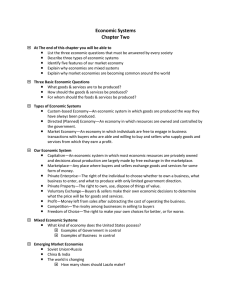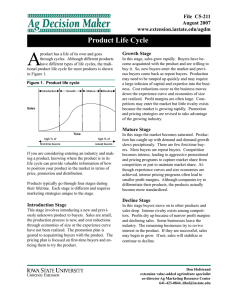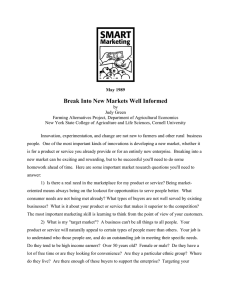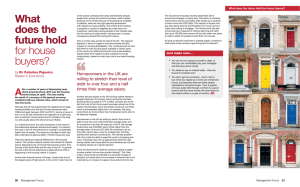Property SS & DD Analysis
advertisement
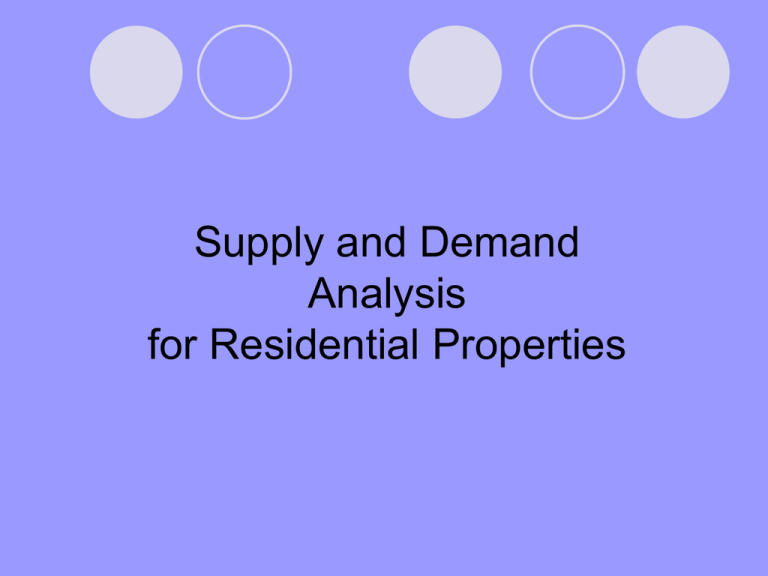
Supply and Demand Analysis for Residential Properties Objectives of Chapter: Discuss the methods that can be used to estimate housing demand. * Estimating demand in general * Local survey-based methods Expected learning results: Main factors in estimating demand for residential properties in general; Apply some methods of estimating demand for residential properties. Analysing Supply Table 10.2: Over Supply Situation in Johor Bahru, Based on Selected Property Projects % of over supply Project Bukit Indah a) Single-storey terrace b) Double-storey terrace 60% 40% Mutiara Rini a) Double-storey terrace b) Double-storey semi-detached 40% 60% Bandar Baru Uda a) Single-storey terrace b) Apartments 30% 10% Indahpura a) Single-storey terrace b) Double-storey terrace 30% 40% Average 39% Source: Sample survey, 2001. Methods of Estimating Residential Demand Global Demand Analysis Global Residential Demand Total population = 100,000 Eligible age (25 – 49) = 35% Eligible population = 0.35 x 100,000 = 35,000 Employment = 97% Eligible working population = 0.97 x 35,000 = 33,950 Home ownership = 65% First-time buyer potential demand = 0.35 x 33,950 = 11,883 Buying interest: Non first-time buyers = 8% First-time buyers = 30% Overall potential demand: Non first-time buyers = 0.08 x 0.65 x 33,950 = 1,765 First-time buyers = 0.3 x 11,883 = 3,565 Total = 1,765 + 3,565 = 5,330 Income categories: Low-income = 35% Middle-income = 45% Upper income = 20% Demand by income-based market segments: Low-income segment = 0.35 x 5,330 = 1,866 Middle-income segment = 0.45 x 5,330 = 2,399 Upper-income segment = 0.20 x 5,330 = 1,066 Class Exercise A town has a working population of 23,000 people. From this figure, 17% are the first-time eligible buyers while 80% of them are non first-time eligible buyers. From these two categories of buyers, 35% are targeted buyers. Entrance to the labour market is estimated to be 2.5% of the working population and 1% are potential buyers. However, only 1% of them are targeted buyers. About 3% of the population working in the town are inmigrants; 1% out of this figure are first-time buyers while 0.5% are non first-time buyers. From the Property Market Report, (PMR) it was found that alien buyers constitutes 0.2% of the total targeted domestic buyers. The information from the PMR also revealed that the market concentration of residential transaction is 64% from the total real estate transaction. Estimate the demand for properties in the area. If current available stock is 12,000 units, assess the market situation. Answer Let say available supply = 12,000 units First-time potential buyers = 5,330 people Assume: one FTPB buys one unit DD-SS balance = 5,300/12,000 = 0.44 DD gap = 12,000-5,330 = 6,670 units Excess supply = 100-44.4% = 55.6% SS excess capacity = 6,670/5,330=125% Severe excess supply, weak demand Local Demand Analysis Local Demand Analysis (cont.) Local Demand Analysis (cont.) Local Demand Analysis (cont.) Local Demand Analysis (cont.) Model-Based Demand Prediction Model-Based Demand Analysis (cont.) Variables used Definition Measurement DEMAND (dependent) Take-up rate % sales performance UNITSUP Unit built No. of units PRODUC Type of product 1=1-ST; 0=otherwise LANREA Average land area Sq.m FLOREA Average floor area Sq.m MIDPRICE Mid-point price RM/unit LOCQUAL Quality of project location 1=if strategic; 0=otherwise Variable Model-Based Demand Analysis (cont.) qU = X + u where qU is (n x 1) column vector of sales performance; X is (n x m) vector of product, locational, and neighbourhood attributes, plus some other pertinent factors influencing sales performance; is (n x 1) column vector of parameter estimates, u is (n x 1) column vector of error term. Model-Based Demand Analysis (cont.) QD = qUˆ x QS or QD’ = adj. qUˆ x QS where QD is predicted demand; qUˆ is estimated take-up rate from the statistical model; and QS is number of units of a given product proposed to be built. Model-Based Demand Analysis (cont.) Qu = 71.615 + 0.002720*UNITSUP – 0.009567*LAREA – 0.001487*FLOREA – 4.506*PROD1 – 13.655*PROD2 – 11.891*PROD3 – 0.000006023*MIDPRICE + 37.438*LOCQUAL Model-Based Demand Analysis (cont.) Thank you!
